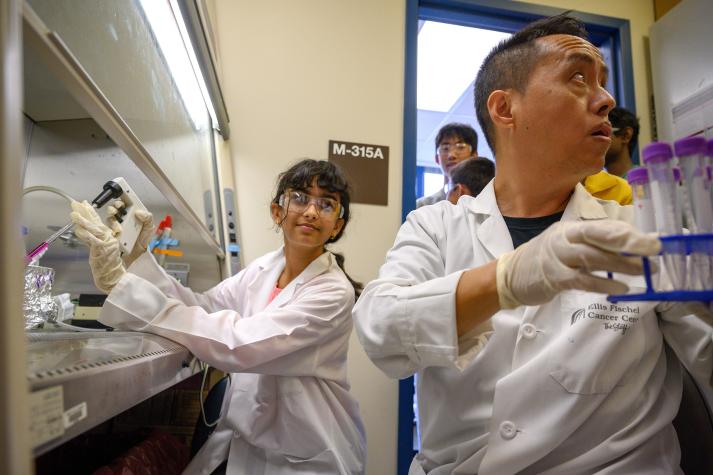COLUMBIA, Mo. – Missouri middle school students learned the basics of cancer biology and pathology research this summer in a hands-on “mini-medical school” camp. Another group of fourth through sixth graders took a walk back through geological time and calculated who ran faster: humans or dinosaurs.
The two camps were among many offered by University of Missouri this summer, with support through The Connector, a joint unit between MU’s Division of Research, Innovation and Impact and the MU Office of Extension and Engagement. The Connector lives up to its name — connecting kids with university researchers, providing hands-on science experiences and piquing interest in science careers.
“There is a lot of research that shows how valuable it is to provide authentic science experiences for youth,” said Christal Huber, The Connector’s senior programing coordinator. “It’s a really effective way to help them develop an interest in science by bringing them to campus and working with scientists, doing real science things. They also get to see adults of all different backgrounds and life experiences engaged in this work, and it encourages them to see themselves in these roles in the future, too.”
The Connector coordinated more than 25 summer enrichment programs that reached more than 800 youths this summer through mini-grants offered through federal American Rescue Plan Act funds and the Missouri AfterSchool Network. These are just some of the programs offered for youth through MU and the other three universities in the University of Missouri System, detailed in the Engagement Mapping Dashboard. (See sidebar.)
The grants help researchers provide learning opportunities for the community – specifically youths. Undergraduate, graduate and professional school students also participate, helping to mentor students.
“Reaching out and engaging the next generation of potential physicians at every age level is very beneficial to our society,” said MU researcher and clinician Yujiang Fang. Fang developed “A Look at Cancer Pathological Research and Cancer Immunotherapy” camp for sixth through eighth graders, with the supervision of Mark Wakefield, professor and chief of the Division of Urology in the MU School of Medicine. Participants met in a medical school lab, learning some of the basics of cell biology, research safety and experiment protocols and models. They practiced using pipettes to get accurate, precise results that can be reproduced experimentally. They learned how to perform their own PCR tests to analyze cell activity.
“I believe that clinical services, teaching and research should all be integrated together,” Fang said. “The person who possesses and can share all three of these assets will be the most productive person in helping to train the next generation of physicians and researchers.” For outreach to youth, the earlier the better, Fang said. “You want to reach them early to excite them about the possibilities while teaching them responsibility and the need for respect for themselves, their educators and their peers.”
These camp experiences also teach collaboration, confidence and interpersonal skills – values essential to student success in whatever career they eventually choose, Fang said.
The Mizzou Rocks! camp for fourth through sixth graders aims to engage youths in the basics of the Earth’s history, said John Huntley, MU associate professor of geological sciences. “Our goal is to produce a more scientifically engaged group of students by sharing information about earth science,” Huntley said.
The 60 participants rotated through three sessions in the MU Geological Sciences Building on campus: an introduction to Missouri rocks, minerals and fossils; an exercise to calculate whether students could outrun the dinosaur whose footprints were taped to the floor, and a walk through geological time, illustrated using images from a mural in the building’s west stairwell showing 635 million years of Earth history. The mural was created by medical illustrator Stacy Cheavens and geology professor Jim Schiffbauer.
An afternoon field trip to Rock Bridge State Park gave students a look at local geology in place, as they learned about fossils and sedimentary rock formations.
“For a lot of kids, these types of interactions can have a big impact on their lives and interests — specifically in seeing that science is something they can do. Seeing it as a career path they can choose, as something they can get excited about is huge,” Huntley said. “At a minimum, it expands their understanding of the world and the importance of science in their everyday lives.”
Mark your calendars starting February 2025 and be on the lookout for the 2025 MU summer enrichment schedule. Limited tuition assistance is available for eligible students on select camps.
Check out the Engagement Mapping Dashboard for a look at data about youth programs at all four University of Missouri System universities. The dashboard details efforts to provide hands-on time in the classroom and authentic enrichment experiences. This information is part of Community Connect, an online tool that features information about outreach events, activities and programs offered to the public through all four universities.
Contact: Christal Huber, 573-884-4334

